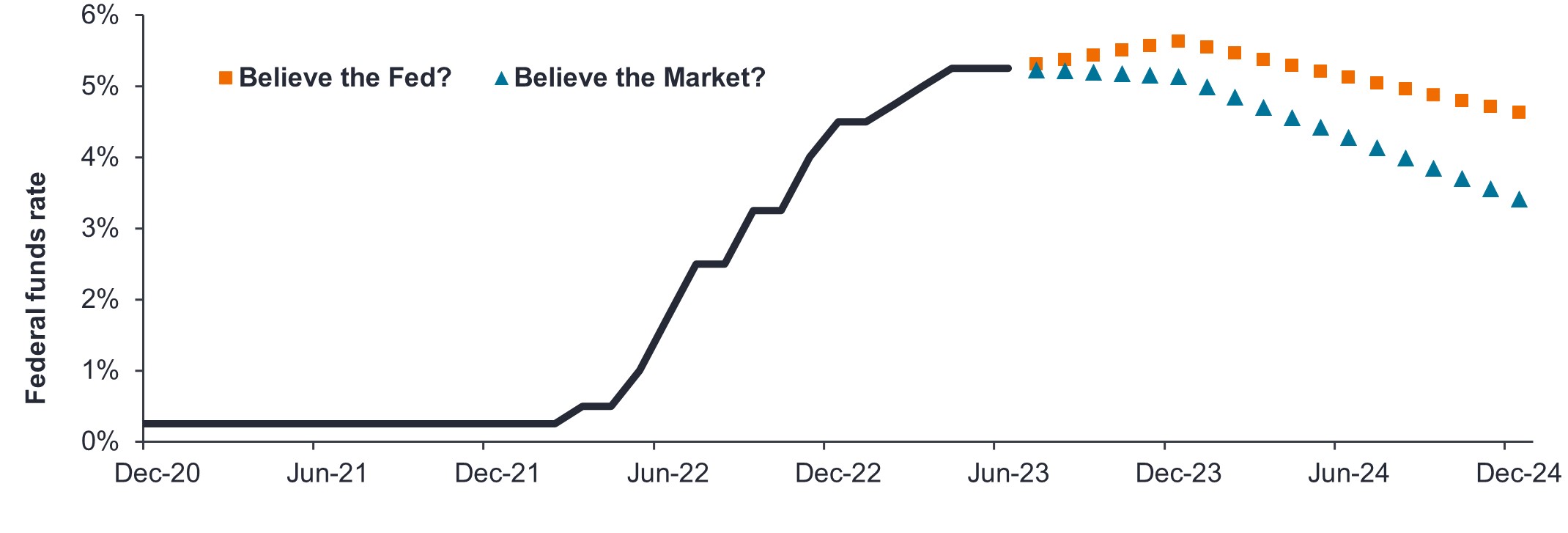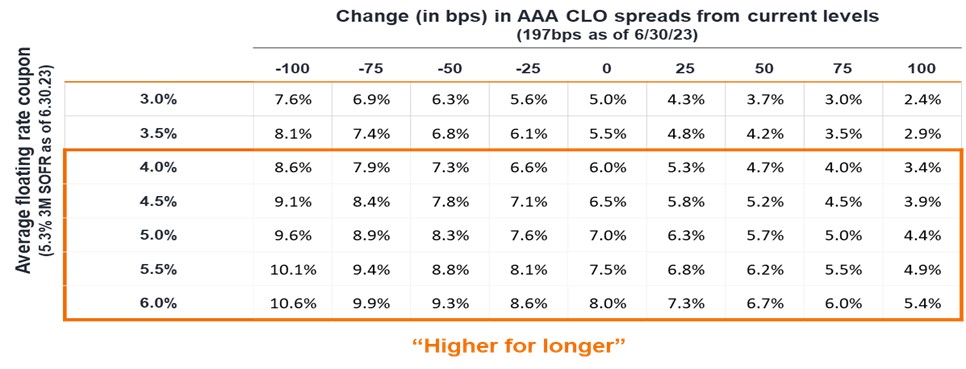How a hawkish Fed may impact AAA CLO returns
Portfolio Managers John Kerschner, Nick Childs, and Jessica Shill discuss what could be in store for AAA CLO returns given a still-hawkish Federal Reserve (Fed).

4 minute read
Key takeaways:
- The Fed recently reaffirmed its hawkish stance with another 25 basis-point hike and dot plot projections that indicate rates are likely to stay higher for longer.
- While the market continues to adopt a more dovish view than the Fed, neither party expects the federal funds rate to drop below 4% within the next 12 months.
- Considering historically high yields and wide spread levels, we believe AAA CLOs remain a strong choice for investors seeking to capitalize on the higher-for-longer rate environment.
Despite taking a brief pause from its rate-hiking cycle in June, the Federal Reserve (Fed) recently reaffirmed its hawkishness – that is, its intention to continue raising rates to fight inflation – with another 25-basis point (bp) rate hike, while leaving the door open for more to come. It also reiterated its stance that rates would remain higher for longer: The median year-end projection for the federal funds rate per the Fed’s Dot Plot – a chart showing each member’s forecast – increased to 5.6% in June from 5% in the prior quarter.
The interest-rate picture
The market has persistently underestimated the Fed’s resolve since 2022 and continues to adopt a more dovish view than the Fed itself. As shown in Exhibit 1, the market’s expectation for the future path of interest rates is noticeably lower than the Fed’s own projections.
Exhibit 1: Expectations for the future path of interest rates
The Fed and the market do not agree.
 Source: Bloomberg as of 30 June 2023. “Believe the Fed?” reflects the median federal funds rate of the July Fed Dot Plot, while “Believe the Market” reflects the federal funds rate forward curve (i.e., the market’s expectations for the future path of the federal funds rate).
Source: Bloomberg as of 30 June 2023. “Believe the Fed?” reflects the median federal funds rate of the July Fed Dot Plot, while “Believe the Market” reflects the federal funds rate forward curve (i.e., the market’s expectations for the future path of the federal funds rate).
In our view, the Fed is likely to stay the course unless it is presented with significant data imploring it to reconsider its hawkish stance. Either way, whether one believes the Fed or the market, neither party expects rates to drop below 4% for at least another 12 months.
As such, we think higher-for-longer rates will continue to underpin attractive yields in floating-rate fixed income such as AAA rated collateralized loan obligations (AAA CLOs). And while various short-term debt instruments such as Treasuries and short-term corporate bonds might also benefit from higher rates, in our view, AAA CLOs appear particularly compelling. This is because of a combination of their AAA credit ratings, inherently low duration due to their floating rate coupons, lower correlation to traditional fixed income, and historically wide spread levels.
The credit spread picture
Credit spreads – the additional yield an asset class offers above risk-free securities of similar duration – on AAA CLOs remain elevated versus both their historical average and short-duration investment-grade corporates. We consider this a positive for the asset class.
To illustrate, notwithstanding its better average credit quality, the yield to worst on the J.P. Morgan AAA CLO Index of 7.3% is almost 1.7% higher than the yield on the Bloomberg 1-3 Year Corporate Index. Additionally, as of 26 July 2023, the yield on AAA CLOs is 1.75% above the overnight funding rate and 32 basis points (bps) above its own 10-year average. In our view, these numbers suggest relative cheapness versus ultrashort-duration alternatives.
We think elevated spread levels in AAA CLOs may provide a cushion for the asset class should rates begin to trend lower in 2024 and beyond. In Exhibit 2, we highlight potential 1-year forward returns for AAA CLOs under various rate and spread scenarios.
According to our analysis, the current combination of high starting yield (around 7.3%) and wide spreads (around 175 bps as of 26 July 2023) may serve as a strong cushion in the event the Fed pivots sooner than expected and/or if spreads widen out to their COVID wide levels of around 270 bps.
Conversely, if rates continue to rise, or stay where they are, with spreads tightening back toward their long-term averages, we think there is significant upside potential for the asset class on a risk-adjusted basis.
Exhibit 2: Potential 1-year forward returns for AAA CLOs under various rate and spread scenarios
 Source: Bloomberg, J.P. Morgan, Janus Henderson Investors, as of 30 June 2023. Hypothetical scenario analysis for illustrative purposes only. Past performance is not guarantee of future returns.
Source: Bloomberg, J.P. Morgan, Janus Henderson Investors, as of 30 June 2023. Hypothetical scenario analysis for illustrative purposes only. Past performance is not guarantee of future returns.
In summary
Considering historically high yields and spread levels, AAA credit quality, lower correlation to traditional fixed income, and inherently low duration, we believe AAA CLOs remain a strong choice for investors seeking to capitalize on the higher-for-longer rate environment.
Average Credit Quality (“ACQ”) is a weighted average of the credit ratings of a portfolio’s holdings. It is calculated by a third party vendor using a linear numeric system. Credit quality ratings for each security in the portfolio reflect the middle rating received from Moody’s, Standard & Poor’s and Fitch, where all three agencies have provided a rating. If only two agencies rate a security, the lowest rating is used. If only one agency rates a security, that rating is used. The vendor assigns each security a numeric value on a linear scale of 2 (highest rated) to 24 (lowest rated). The numerical ratings are then market value weighted to arrive at the aggregate weighted average quality score for the holdings in the portfolio. Non-rated securities are excluded. ACQs are not a rating of the portfolio itself. There are other methods for calculating ACQs that may yield different results.
Basis point (bp) equals 1/100 of a percentage point. 1 bp = 0.01%, 100 bps = 1%.
The Bloomberg US Corporate 1-3 Yr Index measures the investment grade, fixed-rate, taxable corporate bond market with 1-3 year maturities. It includes USD denominated securities publicly issued by US and non-US industrial, utility and financial issuers.
Credit Spread is the difference in yield between securities with similar maturity but different credit quality. Widening spreads generally indicate deteriorating creditworthiness of corporate borrowers, and narrowing indicate improving.
U.S. Treasury securities are direct debt obligations issued by the U.S. Government. With government bonds, the investor is a creditor of the government. Treasury Bills and U.S. Government Bonds are guaranteed by the full faith and credit of the United States government, are generally considered to be free of credit risk and typically carry lower yields than other securities.
Duration measures a bond price’s sensitivity to changes in interest rates. The longer a bond’s duration, the higher its sensitivity to changes in interest rates and vice versa.
J.P. Morgan CLO AAA Index is designed to track the AAA-rated components of the USD-denominated, broadly syndicated CLO market.
Yield to worst (YTW) is the lowest yield a bond can achieve provided the issuer does not default and accounts for any applicable call feature (ie, the issuer can call the bond back at a date specified in advance). At a portfolio level, this statistic represents the weighted average YTW for all the underlying issues.
Yield cushion, defined as a security’s yield divided by duration, is a common approach that looks at bond yields as a cushion protecting bond investors from the potential negative effects of duration risk. The yield cushion potentially helps mitigate losses from falling bond prices if yields were to rise.
IMPORTANT INFORMATION
Collateralized Loan Obligations (CLOs) are debt securities issued in different tranches, with varying degrees of risk, and backed by an underlying portfolio consisting primarily of below investment grade corporate loans. The return of principal is not guaranteed, and prices may decline if payments are not made timely or credit strength weakens. CLOs are subject to liquidity risk, interest rate risk, credit risk, call risk and the risk of default of the underlying assets.
Fixed income securities are subject to interest rate, inflation, credit and default risk. The bond market is volatile. As interest rates rise, bond prices usually fall, and vice versa. The return of principal is not guaranteed, and prices may decline if an issuer fails to make timely payments or its credit strength weakens.
These are the views of the author at the time of publication and may differ from the views of other individuals/teams at Janus Henderson Investors. References made to individual securities do not constitute a recommendation to buy, sell or hold any security, investment strategy or market sector, and should not be assumed to be profitable. Janus Henderson Investors, its affiliated advisor, or its employees, may have a position in the securities mentioned.
Past performance does not predict future returns. The value of an investment and the income from it can fall as well as rise and you may not get back the amount originally invested.
The information in this article does not qualify as an investment recommendation.
Marketing Communication.
Important information
Please read the following important information regarding funds related to this article.
- An issuer of a bond (or money market instrument) may become unable or unwilling to pay interest or repay capital to the Fund. If this happens or the market perceives this may happen, the value of the bond will fall.
- When interest rates rise (or fall), the prices of different securities will be affected differently. In particular, bond values generally fall when interest rates rise (or are expected to rise). This risk is typically greater the longer the maturity of a bond investment.
- The Fund invests in high yield (non-investment grade) bonds and while these generally offer higher rates of interest than investment grade bonds, they are more speculative and more sensitive to adverse changes in market conditions.
- Some bonds (callable bonds) allow their issuers the right to repay capital early or to extend the maturity. Issuers may exercise these rights when favourable to them and as a result the value of the Fund may be impacted.
- The Fund may use derivatives to help achieve its investment objective. This can result in leverage (higher levels of debt), which can magnify an investment outcome. Gains or losses to the Fund may therefore be greater than the cost of the derivative. Derivatives also introduce other risks, in particular, that a derivative counterparty may not meet its contractual obligations.
- If the Fund holds assets in currencies other than the base currency of the Fund, or you invest in a share/unit class of a different currency to the Fund (unless hedged, i.e. mitigated by taking an offsetting position in a related security), the value of your investment may be impacted by changes in exchange rates.
- When the Fund, or a share/unit class, seeks to mitigate exchange rate movements of a currency relative to the base currency (hedge), the hedging strategy itself may positively or negatively impact the value of the Fund due to differences in short-term interest rates between the currencies.
- Securities within the Fund could become hard to value or to sell at a desired time and price, especially in extreme market conditions when asset prices may be falling, increasing the risk of investment losses.
- The Fund could lose money if a counterparty with which the Fund trades becomes unwilling or unable to meet its obligations, or as a result of failure or delay in operational processes or the failure of a third party provider.
Specific risks
- An issuer of a bond (or money market instrument) may become unable or unwilling to pay interest or repay capital to the Fund. If this happens or the market perceives this may happen, the value of the bond will fall.
- When interest rates rise (or fall), the prices of different securities will be affected differently. In particular, bond values generally fall when interest rates rise (or are expected to rise). This risk is typically greater the longer the maturity of a bond investment.
- The Fund invests in high yield (non-investment grade) bonds and while these generally offer higher rates of interest than investment grade bonds, they are more speculative and more sensitive to adverse changes in market conditions.
- Some bonds (callable bonds) allow their issuers the right to repay capital early or to extend the maturity. Issuers may exercise these rights when favourable to them and as a result the value of the Fund may be impacted.
- If a Fund has a high exposure to a particular country or geographical region it carries a higher level of risk than a Fund which is more broadly diversified.
- The Fund may use derivatives to help achieve its investment objective. This can result in leverage (higher levels of debt), which can magnify an investment outcome. Gains or losses to the Fund may therefore be greater than the cost of the derivative. Derivatives also introduce other risks, in particular, that a derivative counterparty may not meet its contractual obligations.
- When the Fund, or a share/unit class, seeks to mitigate exchange rate movements of a currency relative to the base currency (hedge), the hedging strategy itself may positively or negatively impact the value of the Fund due to differences in short-term interest rates between the currencies.
- Securities within the Fund could become hard to value or to sell at a desired time and price, especially in extreme market conditions when asset prices may be falling, increasing the risk of investment losses.
- The Fund may incur a higher level of transaction costs as a result of investing in less actively traded or less developed markets compared to a fund that invests in more active/developed markets.
- Some or all of the ongoing charges may be taken from capital, which may erode capital or reduce potential for capital growth.
- The Fund could lose money if a counterparty with which the Fund trades becomes unwilling or unable to meet its obligations, or as a result of failure or delay in operational processes or the failure of a third party provider.
- In addition to income, this share class may distribute realised and unrealised capital gains and original capital invested. Fees, charges and expenses are also deducted from capital. Both factors may result in capital erosion and reduced potential for capital growth. Investors should also note that distributions of this nature may be treated (and taxable) as income depending on local tax legislation.
- The Fund invests in Asset-Backed Securities (ABS) and other forms of securitised investments, which may be subject to greater credit / default, liquidity, interest rate and prepayment and extension risks, compared to other investments such as government or corporate issued bonds and this may negatively impact the realised return on investment in the securities.
Specific risks
- An issuer of a bond (or money market instrument) may become unable or unwilling to pay interest or repay capital to the Fund. If this happens or the market perceives this may happen, the value of the bond will fall.
- When interest rates rise (or fall), the prices of different securities will be affected differently. In particular, bond values generally fall when interest rates rise (or are expected to rise). This risk is typically greater the longer the maturity of a bond investment.
- Some bonds (callable bonds) allow their issuers the right to repay capital early or to extend the maturity. Issuers may exercise these rights when favourable to them and as a result the value of the Fund may be impacted.
- The Fund may use derivatives to help achieve its investment objective. This can result in leverage (higher levels of debt), which can magnify an investment outcome. Gains or losses to the Fund may therefore be greater than the cost of the derivative. Derivatives also introduce other risks, in particular, that a derivative counterparty may not meet its contractual obligations.
- If the Fund holds assets in currencies other than the base currency of the Fund, or you invest in a share/unit class of a different currency to the Fund (unless hedged, i.e. mitigated by taking an offsetting position in a related security), the value of your investment may be impacted by changes in exchange rates.
- When the Fund, or a share/unit class, seeks to mitigate exchange rate movements of a currency relative to the base currency (hedge), the hedging strategy itself may positively or negatively impact the value of the Fund due to differences in short-term interest rates between the currencies.
- Securities within the Fund could become hard to value or to sell at a desired time and price, especially in extreme market conditions when asset prices may be falling, increasing the risk of investment losses.
- The Fund could lose money if a counterparty with which the Fund trades becomes unwilling or unable to meet its obligations, or as a result of failure or delay in operational processes or the failure of a third party provider.
Specific risks
- An issuer of a bond (or money market instrument) may become unable or unwilling to pay interest or repay capital to the Fund. If this happens or the market perceives this may happen, the value of the bond will fall. High yielding (non-investment grade) bonds are more speculative and more sensitive to adverse changes in market conditions.
- When interest rates rise (or fall), the prices of different securities will be affected differently. In particular, bond values generally fall when interest rates rise (or are expected to rise). This risk is typically greater the longer the maturity of a bond investment.
- Some bonds (callable bonds) allow their issuers the right to repay capital early or to extend the maturity. Issuers may exercise these rights when favourable to them and as a result the value of the Fund may be impacted.
- Emerging markets expose the Fund to higher volatility and greater risk of loss than developed markets; they are susceptible to adverse political and economic events, and may be less well regulated with less robust custody and settlement procedures.
- The Fund may use derivatives to help achieve its investment objective. This can result in leverage (higher levels of debt), which can magnify an investment outcome. Gains or losses to the Fund may therefore be greater than the cost of the derivative. Derivatives also introduce other risks, in particular, that a derivative counterparty may not meet its contractual obligations.
- If the Fund holds assets in currencies other than the base currency of the Fund, or you invest in a share/unit class of a different currency to the Fund (unless hedged, i.e. mitigated by taking an offsetting position in a related security), the value of your investment may be impacted by changes in exchange rates.
- When the Fund, or a share/unit class, seeks to mitigate exchange rate movements of a currency relative to the base currency (hedge), the hedging strategy itself may positively or negatively impact the value of the Fund due to differences in short-term interest rates between the currencies.
- Securities within the Fund could become hard to value or to sell at a desired time and price, especially in extreme market conditions when asset prices may be falling, increasing the risk of investment losses.
- The Fund involves a high level of buying and selling activity and as such will incur a higher level of transaction costs than a fund that trades less frequently. These transaction costs are in addition to the Fund's ongoing charges.
- The Fund could lose money if a counterparty with which the Fund trades becomes unwilling or unable to meet its obligations, or as a result of failure or delay in operational processes or the failure of a third party provider.
- In addition to income, this share class may distribute realised and unrealised capital gains and original capital invested. Fees, charges and expenses are also deducted from capital. Both factors may result in capital erosion and reduced potential for capital growth. Investors should also note that distributions of this nature may be treated (and taxable) as income depending on local tax legislation.
- The Fund invests in Asset-Backed Securities (ABS) and other forms of securitised investments, which may be subject to greater credit / default, liquidity, interest rate and prepayment and extension risks, compared to other investments such as government or corporate issued bonds and this may negatively impact the realised return on investment in the securities.





